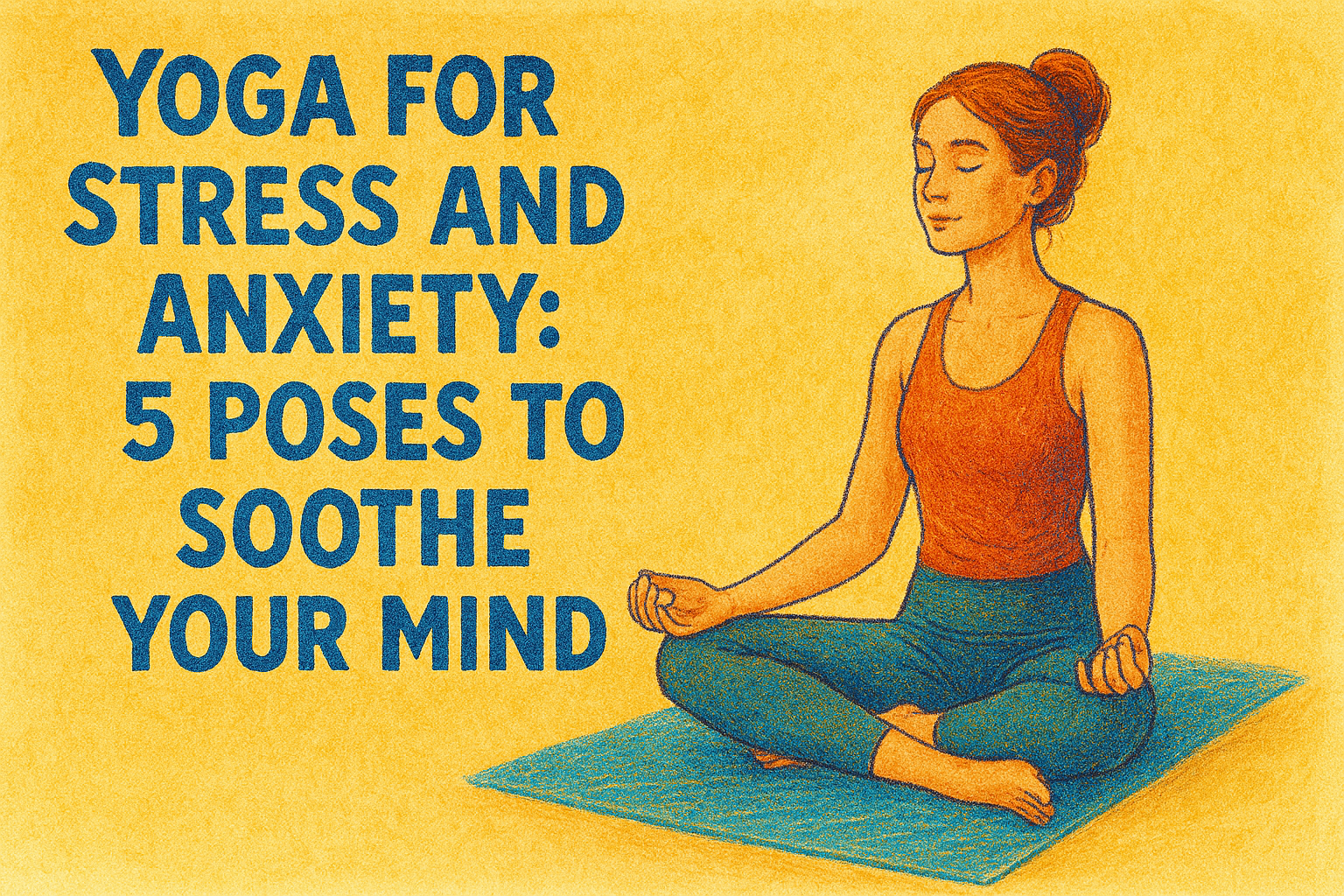Yoga for Stress and Anxiety: 5 Poses To Soothe Your Mind
Blog Yoga Schools
Stress and anxiety is a common challenges for most of the people in this fast-paced world. Work pressures, relationship concerns, and day to day responsibilities can have a huge impact on mental health. Yoga for stress relief & relaxation is a safe solution to bring down the anxiety and create tranquility in the mind. Yoga involves breath control, meditation, and electrical postures, all of which contribute to reduced tension, improved mood, and a state of relaxation.
There are actual studies done scientifically that show that daily yoga can significantly reduce cortisol levels (the stress hormone), improve mental clarity and enable one to become more emotionally self-sufficient. Whether you are facing some sort of stress every now and then or deal with chronic anxiety, adding yoga to your schedule can help a lot.
So yoga is a practice that boosts both physical and mental flexibility! Another method discovered through a consistent practice are mindful individuals that help respond to stressful situations with more clarity. You must practice with consistent, gentle awareness and patience to use yoga for stress relief effectively. Your mental and emotional state will be greatly improved by even a few minutes of practice each day
Child’s Pose (Balasana)
How to Do It
From kneeling on the floor, start by sitting back on your heels. Reach your arms out in front of you and lower your chest down toward the floor. Let your forehead rest on the mat there, and breathe slowly and deeply. 1–2 minutes, working with the breath
Additional Tips
If your knees are sensitive, put a cushion between your thighs and calves for support. Continue with slow exhalation to increase the relaxation effect.
Hold the arms in front of you or let them come down beside the sides of your body for variations.
Cat-Cow Pose (Marjaryasana-Bitilasana)
How It Helps
The dynamic exchanges between these two postures increase spinal flexibility, enhance circulation and relieve stress. The slow flow also calms the mind and releases stored tension. Coupling movement with breath, Cat-Cow Pose helps you become more mindful and aids in relaxation.
How to Do It
- Beggin on your hands and knees in tabletop position.
- During inhalation you should raise your head while arching your back (Cow Pose).
- Exhale, round spine, tuck chin (Cat Pose).
- Do this movement for 1–2 minutes, matching breath with movement.
Additional Tips
- Take your time and avoid any unnecessary pressure.
- If you keep your eyes closed, it helps to focus on the breath to deepen the calming effects.
- This pose can also relieve mild back pain and stiffness.
Uttanasana (Standing Forward Bend)
How It Helps
Standing Forward Bend stretches the hamstrings and lower back while fostering relaxation. It promotes blood flow to the brain, which alleviates stress and anxiety. The gentle inversion of this pose releases tension that builds in the spine and shoulders, the classic stashes for stress accumulation
How to Do It
- Stand with feet hips-distance apart.
- Gradually bend in half, reaching toward your toes.
- Drop the head and soften the neck.
- Hold for 30 seconds to 1 minute and breathe deeply.
Additional Tips
- If you have tight hamstrings, keep a very small bend in your knees to keep it more comfortable.
- So see if you can sway a little bit side to side, just to let some more tension go.
- Rather than forcing a stretch, focus on creating space in the spine.
VIPARITA KARANI | LEGS UP THE WALL POSE
How It Helps
This gentle position encourages relaxation, alleviates fatigue and soothes the nervous system. It alleviates anxiety and promotes circulation. The inversion of the blood flow reduces inflammation in the legs and is also a very good way to regulate the nervous system.
How to Do It
- You should position yourself against a wall in a sitting posture before moving your legs upward.
- You should position yourself against a wall in a sitting posture before moving your legs upward.
- Place your arms down by your sides and close your eyes.
- Remain in this pose for 5–10 minutes, inhaling deeply.
Additional Tips
- Put a cushion or folded up blanket under your hips for support.
- Use slow, rhythmic breathing as a concentration technique to aid relaxation.
- This pose is excellent for combating insomnia and fatigue
Corpse Pose (Savasana)
How It Helps
Corpse Pose is the final resting posture that helps the body and mind relax completely. It reduces stress levels, and lowers blood pressure, and increases well being, This pose facilitates a meditative state that brings forth healing and renewal
How to Do It
- Befittingly lie on your back with your arms resting at your sides.
- Breathe slowly and deeply with your eyes closed.
- Release all tension from your body; allow your body to relax completely.
- Release all tension from your body; allow your body to relax completely
Additional Tips
- Add another layer of warmth and comfort with a blanket.
- If you want, play some soothing music or guided meditation to aid relaxation.
- Concentrate on the feeling of air passing in and out of your body.
Does Yoga Have The Ability To Cure anxiety Once And For All?
Yoga is not a remedy for anxiety, but it can be invaluable in coping with the symptoms. It is a powerful mental treatment as regular practice decreases stress hormones, enhances mindfulness, relaxes responses.
How Many Times A Week Do I Need to Do Yoga For Relieving Stress?
Even regular yoga practice—even 3–5 times a week—can have a marked positive effect on stress and anxiety levels. Even a little yoga each day can work well.
Do I Require Any Equipment To do These Yoga Poses?
No, just a yoga mat or something that serves as such. These poses take up little space and can be performed at home with no special equipment.
Can beginners Perform These Yoga Poses?
Yes! The asanas (yogic poses) listed here are beginner-friendly and easy to perform. If you are a beginner at yoga, take it easy and pay attention to your body.
Conclusion
Yoga is one of the strongest natural tools to soothe the mind, body and spirit to reduce stress. The five poses below — Child’s Pose, Cow Cat Pose, Standing Forward Bend Legs-Up-the-Wall Pose and Corpse Pose — are simple to perform but surprisingly powerful when it comes to releasing tension and inviting relaxation. When used in conjunction with everyday routine these poses can really help to cope with anxiety and give mental sharpness and peace.
Remember, consistency is key. Joint mobility strengthens the tendons, ligaments, fusion, and clips around it, improves blood circulation, increases flexibility, increases the ability to control, prevent injury, and prevention of injury. Get started today, and take your first step towards a calmer and balanced mind!
